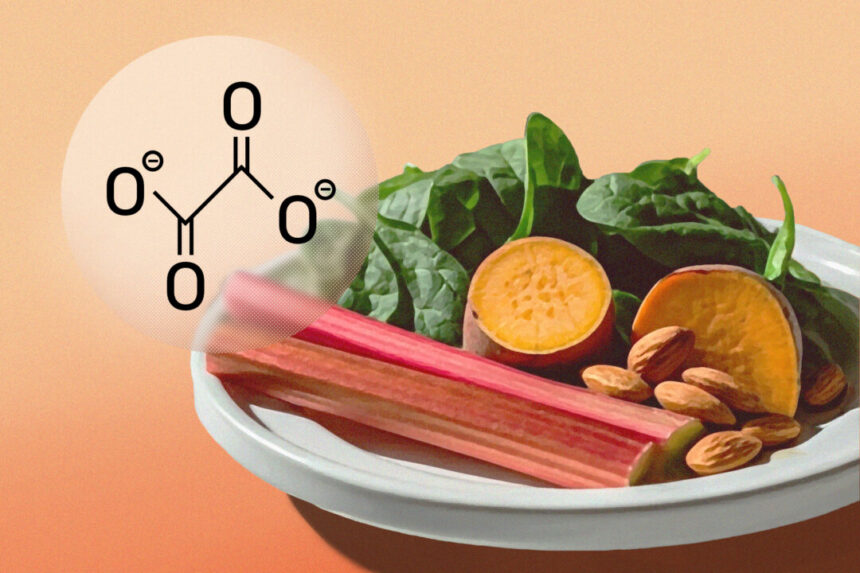While often considered to be healthy, some vegetables and fruits contain compounds known as “oxalates,” which can lead to health problems.
Many people prioritize their health by consuming superfoods like spinach, almonds, and sweet potatoes. However, for some individuals, these foods may contribute to chronic health issues, with oxalates being the suspected culprit.
Oxalates are naturally occurring compounds present in various plant-based foods, including leafy greens, nuts, seeds, and certain fruits. They are also produced by the human body.
The role of oxalates in human health remains unclear, but research suggests that certain individuals, particularly those with specific genetic predispositions or gut health issues, may be more susceptible to health problems associated with high oxalate consumption.
Factors such as year-round access to high-oxalate foods, increased intake of processed foods and seed oils, chronic stress, and gastrointestinal dysbiosis may contribute to increased vulnerability to oxalate-related issues in some individuals.
It is essential to recognize the intricate relationship between diet, lifestyle, and individual biochemistry when it comes to nutrition and health, as what works for one person may not work for another.
A Case Study: Oxalate Overload
Sally Norton, a Cornell University nutritional science graduate, struggled with various health issues for over three decades while following what she believed to be a perfect diet. After eliminating high-oxalate foods from her diet, Norton experienced a significant improvement in her health, emphasizing that even seemingly healthy foods can sometimes cause unexpected health challenges.
But what exactly are oxalates, and should they be a cause for concern?
What Are Oxalates?
Oxalates are compounds formed when oxalic acid binds with minerals like calcium, potassium, or magnesium, creating substances such as calcium oxalate, potassium oxalate, or magnesium oxalate. These oxalates can form tiny crystals in the body.
While oxalic acid and oxalate crystals play various roles in plant growth, pH regulation, and detoxification of heavy metals, their effects on human health are more complex. Oxalates are considered anti-nutrients because they can interfere with the absorption of essential minerals such as calcium, iron, and magnesium.
When renal clearance is insufficient, oxalates can accumulate and form crystals in the body, potentially leading to health issues. The most well-known oxalate crystals are associated with kidney stone formation, with a significant portion of these stones comprising calcium oxalate.
Despite their negative effects, oxalates are naturally produced in the body, suggesting that they may play essential roles that are not yet fully understood.
Researchers emphasize the importance of achieving a balance between oxalate production and removal, as an imbalance may lead to toxicity and crystal formation.
More research is needed to comprehend the complexities of oxalate and its impact on health, particularly in modern society where various factors may contribute to increased oxalate-related issues.
Is Modern Life Creating an Oxalate Problem?
Changes in Modern Food Supply
Historically, high-oxalate foods were only available seasonally. Today, foods rich in oxalates, such as spinach and almonds, are readily available year-round. The shift in dietary practices towards consuming vegetable oils, which can lead to oxalate production in the body, has become common. Americans consume a significant portion of their diet from grains, some of which are high in oxalates. High-dose vitamin C supplements and certain foods like gelatin have also been linked to increased oxalate levels.
The prevalence of modern diseases, such as chronic conditions affecting millions of Americans, has been associated with increased oxidative stress levels and oxalate metabolism. Factors like processed foods, antibiotic overuse, and chronic stress can disrupt the gut microbiome, leading to higher oxalate levels. Various health conditions, including inflammatory bowel disease, have been linked to fat malabsorption and increased oxalate absorption.
The impact of gut microbiota on oxalate levels is crucial, as bacteria like Oxalobacter formigenes play a role in breaking down oxalates in the gastrointestinal tract. Maintaining a healthy gut microbiome may help reduce oxalate buildup in the body. The absence of oxalate-degrading microbes can contribute to oxalate-related health issues in susceptible individuals.
Recent research has linked oxalate overload to various health conditions, including cardiomyopathy, chronic pain, visual disturbances, and arthritis. The toxic effects of oxalates have been recognized for centuries, with doctors in the 19th century noting its harmful effects beyond kidney stones. Maintaining a balanced diet and a healthy gut microbiome may help mitigate the risks associated with oxalate consumption. In certain instances, hyperoxaluria can result in oxalate arthritis.
Digestive problems: Oxalates have the potential to irritate the digestive tract lining, leading to leaky gut syndrome and other gastrointestinal issues.
Autoimmunity: Inflammation triggered by oxalate crystals may contribute to autoimmune conditions. People with celiac disease have been found to have higher oxalate levels, as indicated in an article published in the 2016 Journal of Gluten Sensitivity.
Are Oxalates Affecting You?
According to Masterjohn, some individuals may have a genetic mutation that increases oxalate production susceptibility, while others without the mutation could still be sensitive to oxalates.
Factors that may increase vulnerability include:
– History of recurrent antibiotic use or kidney stones
– Digestive disorders such as Crohn’s disease or leaky gut syndrome
– Genetic predisposition to oxalate sensitivity
– Bariatric surgery
– Specific nutrient deficiencies, particularly vitamin B6
– Chronic yeast and fungal infections
– Diets high in oxalate-rich foods
Symptoms of oxalate issues can be nonspecific and overlap with various other conditions. Some indicators that oxalates might be problematic include:
– Recurring kidney stones
– Unexplained joint pain or arthritis-like symptoms
– Persistent digestive problems
– Frequent urinary tract infections or bladder pain
– Chronic fatigue or brain fog
– Skin conditions like rashes or hives
– Symptoms worsening after consuming high-oxalate foods
“If you’re dealing with chronic health issues without a clear cause, it’s worth considering whether oxalates could be a factor,” Norton suggested. Addressing oxalate overload can potentially heal tissues and reverse chronic conditions.
Identifying Oxalate Sensitivity
While there isn’t a definitive test for oxalate sensitivity, several diagnostic methods can be helpful:
– Urinary oxalate testing: Measures oxalate levels in urine, but daily fluctuations may impact accuracy
– Gut bacteria composition testing: Identifies dysbiosis and potential lack of oxalate-degrading bacteria
– Nutrient deficiency testing: Checks levels of vitamin B6, calcium, magnesium, zinc, thiamin, and iron
– Yeast and fungal infection testing: Detects infections contributing to oxalate production in the body
How to Lower Oxalate Levels
If oxalates are suspected to impact health, several strategies can help reduce oxalate intake:
– Address nutrient deficiencies: Correcting deficiencies like vitamin B6 or thiamin can lower oxalate production
– Cook high-oxalate foods: Boiling can reduce oxalate content in some vegetables
– Stay hydrated: Adequate water intake can prevent crystal formation and promote oxalate excretion
– Support gastrointestinal health: Probiotics and prebiotics may reduce oxalate absorption and enhance microbial metabolism of oxalates
– Balance your diet: Ensure a diverse intake of nutrients from various food sources
– Eliminate Seed Oils: Industrial seed oils can raise oxalate levels through lipid peroxidation
– Increase calcium and/or magnesium intake: Consuming calcium-rich and magnesium-rich foods with oxalate-containing foods can decrease oxalate absorption
Continued in the next message… Can you please rewrite this sentence?
Source link





